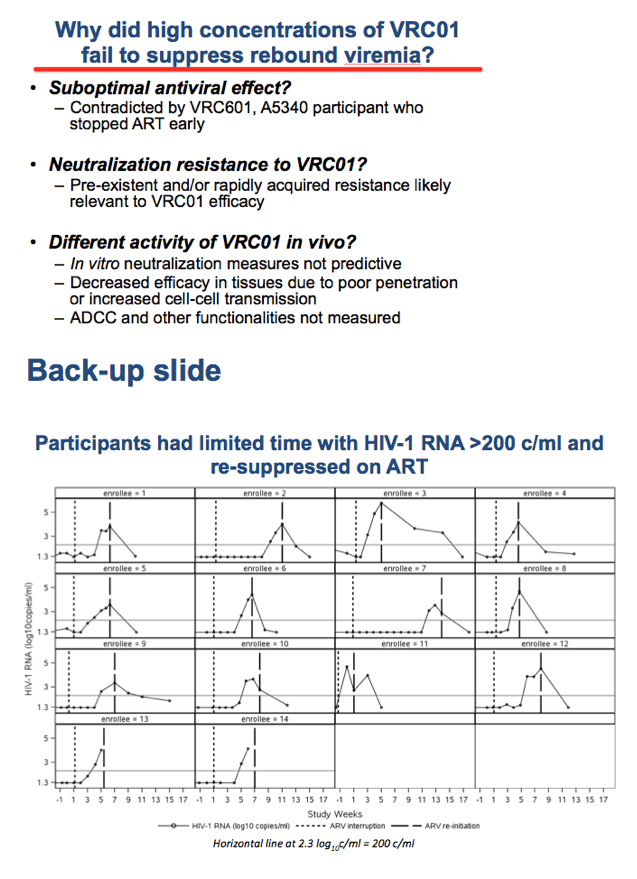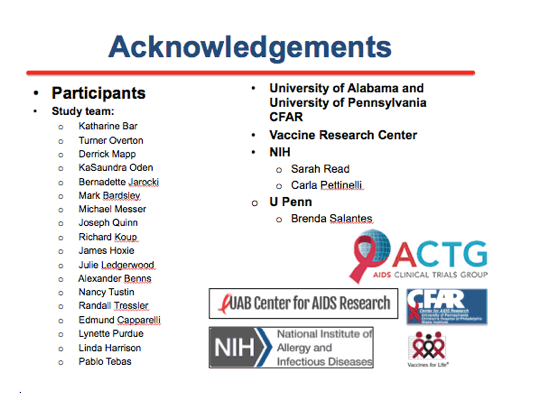 |
 |
 |
| |
ACTG A5340: the effect of VRC01 on viral kinetics after analytical treatment interruption .........VRC01, a Broadly Neutralizing Antibody, Does Not Maintain HIV Control When ART Stops
|
| |
| |
Conference on Retroviruses and Opportunistic Infections (CROI), February 22-25, 2016, Boston
Mark Mascolini
WEBCAST link: http://www.croiwebcasts.org/console/player/29460?mediaType=audio&
VRC01, a much-studied broadly neutralizing anti-HIV monoclonal antibody (bnAb) "modestly" delayed viral rebound when antiretroviral therapy (ART) stopped in AIDS Clinical Trials Group (ACTG) protocol A5340 [1].
Targeting the CD4 binding site of HIV's envelope protein, VRC01 broadly neutralizes about 90% of HIV-1 isolates across diverse subtypes. When passively administered, the bnAb prevents HIV-1 transmission in humanized mice and macaques and transiently reduces viral load in HIV-positive humans by up to 1000-fold.
ACTG A5340 aimed to see if VRC01 is safe and tolerable, if it maintains high plasma levels, if it delays or prevents rebound when ART stops, and if it cuts the size of the latent reservoir. Study participants had a viral load below 50 copies for more than 6 months while on a protease inhibitor regimen or integrase inhibitor regimen. Everyone had a CD4 count above 400 and a CD4 nadir above 200. Participants received VRC01 at a dose of 40 mg/kg every 3 weeks. One week after the first VRC01 infusion, participants suspended ART for 8 weeks. Researchers measured plasma viremia weekly and resumed ART if they confirmed a rebound.
Fourteen people enrolled, all of them men. Median age stood at 38 (range 27 to 52), half were black, half white, and 14% Latino. Median CD4 count measured 896 (range 470 to 1586) and time on ART ranged from 2.7 to 14.5 years. Most participants, 71%, were taking an integrase inhibitor. One person dropped out before stopping ART.
There were no grade 3 or 4 events during the study and no grade 2 events associated with VRC01 infusion. VRC01 infusion yielded high plasma levels for the 8 weeks after ART interruption. Despite these high levels, 11 men had a viral rebound within 5 weeks of stopping ART, while the remaining 2 had rebounds 8 and 11 weeks after suspending ART. Treatment resumed a median of 7 days after confirmed rebound (range 0 to 9). Time to rebound could not be linked to VRC01 level, age, nadir CD4 count, entry CD4 count, or time on ART. Twelve of 13 men had rebounds with VRC01 plasma levels above 50 ug/mL.
Compared with historical controls who interrupted ART in ACTG trials, a significantly higher proportion of VRC01 recipients maintained viral suppression through 4 weeks (38% versus 13%, P = 0.04) but not through 8 weeks (8% versus 3%, P = 0.44). In some participants, viral sequence analysis suggested that VRC01 exerts selective pressure that restricted viral rebound. Other sequence analyses did not support that possibility. Ongoing analyses are addressing measures of inflammation, cellular activation, and the latent reservoir.
The ACTG team concluded that VRC01 infusion is safe and well tolerated but only "modestly delays the return of viremia when compared to historical controls." The investigators called for further study to test combination bnAbs, to assess baseline bnAb resistance, and to identify the bnAb mechanism of action in humans.
Reference
1. Bar KJ, Harrison LJ, Overton ET, et al. ACTG 5340: The effect of VRC01 on viral kinetics after analytic treatment interruption. Conference on Retroviruses and Opportunistic Infections (CROI), February 22-25, 2016, Boston. Abstract 32LB
-----------------









|
| |
|
 |
 |
|
|